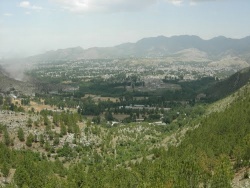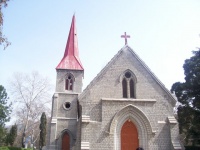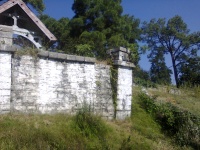Abbottabad
| Abbottabad | |
|---|---|

| |
| Presidency: Bengal | |
| Coordinates: | 34.191057°N 73.330059°E |
| Altitude: | 1,260 m (4,134 ft) |
| Present Day Details | |
| Place Name: | Abbottabad |
| State/Province: | Khyber Pakhtunkhwa, Old NWFP |
| Country: | Pakistan |
| Transport links | |
| FibiWiki Maps | |
|---|---|
| See our interactive map of this location showing places of interest during the British period | |
| Abbottabad |
Abbottabad was the main town and capital in Hazara District of the North West Frontier Province during the British period. It is around 35 miles north of Rawalpindi. Some of the main Hill stations near Abbottabad include Thandiani, Dunga Gali, Bara Gali, Khanspur and Nathiagali.
Contents
Name origin
Abbottabad is named after its founder and first Deputy Commissioner of the Hazara region, James Abbott, a British officer. Abbott founded the town in January 1853[1]. However, soon after founding this town, Abbott was posted away in April 1853 and his successor Deputy Commissioner Herbert Edwardes took on the task of developing it, along the lines envisaged by the founder himself. This was subsequently done, over some years, by Edwardes and his successors, with the result that Abbottabad became noted throughout British India as a small military town of considerable distinction and beauty.
Education
Some of the better known and established schools and colleges in Abbottabad are:
- Army Burn Hall College, formerly Burn Hall School, established 1947-48 by the Mill Hill Missionaries
- The Old Municipal Vernacular High School (now The Government High School and College No 1)
- The Old Albert Victor Anglo-Vernacular High School (now The Government High School and College No 2)
Hospitals
- The Combined Military Hospitals, Pakistan Abbottabad branch Class B (Wikipedia)
Former Boer War POW Camp
Kakul (Kakool) is situated 5 kms northeast of Abbottabad. The following information was sent in by Prof Omer SK Tarin. Director, TSI, Abbottabad, Pakistan.
1. Until April 1901 the British captured approx 25,000 Boers. Of these various numbers were sent to various places as POWs (See POW Camps in India-Boer War).
2. Only a total of 9000 Boer POWs were ever sent out to India of this number, and they were held in some 14-15 camps in selected Indian cantonments. About 1000 of this number were sent out to various POW camps in the areas of former British India now comprising Pakistan--Abbottabad was only one of these and the number of POWs here from 1902 onwards until 1904 was around 300-400 most times, and they were never ever more than 400 or so. A few of them succumbed to illness and disease and are still buried here[2] at Kakul/Kakool about 6 kms out of Abbottabad town, within the compound of what is now the PMA (Pakistan Military Academy) there. The majority were all sent home. A member of BACSA, Ms Sue Farrington did a survey of the Boers' graves here in the 1980s-90s and her detailed findings are also available on record I believe. BACSA Website
3. The duty of guarding the Boer POWs fell largely upon the 5th Royal Gurkha Rifles (Frontier Force) as Abbottabad was their home station, and they in fact levelled and prepared the location where the camp was and also looked after their charges in every way. The best account of them is given in the History of the 5th Royal Gurkha Rifles, 1858 to 1928 Aldershot: Gale and Polden, 1928, and this confirms all other records and verifiable sources. A very good mention is also made in an article by C Parrett and Brian Stevens in Durbar: Journal of the IMHS Vol 28, No 1, Spring 2011, regarding Boer POWS in India. IMHS Website
4. Whilst here the Boers also had to do some manual labour in metalling the Havelian-Abbottabad stretch of hill road. The 'Hazara District Gazeteer' for 1907 gives this information.
5. When they left in 1904, the site of their POW camp was partially converted into the Army PT and Mountaineering school and part of it into Royal Indian Army Service Corps (RIASC) local/regional HQ. Both these facilities lasted here until 1947.
6. In 1947 India and Pakistan became independent. In 1947 Pakistan decided to set up its military academy here at Kakul and this was done in 1948, with Brig Ingalls as the first principal/commandant of the PMA. Brig Shuakat Ali Shah followed him in command here in 1956, with my grandfather (then) Colonel Azmat Hayat Khan, as Deputy Commandant. [3]. Since then The Pakistan Military Academy has expanded considerably.
FIBIS resources
- List of Chaplains at St Luke's, Abbottabad
- Surviving graves at the Old Christian Cemetery, Abbottabad
- An article by Professor Omer SK Tarin accompanying these data sets appears in FIBIS Journal 27, Spring 2012, pages 23-29
- Selections from the The Sophia Institute Records, Pakistan - 'The Sophia Institute' is a research and higher educational training organisation in Abbottabad. The institute houses a small library and archives although the larger part of older records have now been passed on to (a) the Empire and Commonwealth Museum UK[4] (b) the National Archives of Pakistan and (c) some university archives in Pakistani universities/departments etc. They are willing to answer/help with queries at a small cost, if people are interested in consulting their records (c 1860s to 1947). As they are a volunteer non profit body and have few staff, responses might take time. If anyone has any query they can email Dr Ilyas Khan, Senior Research Assistant.
Churches
- St Luke's Church - Anglican, consecrated 1864[5].
For enquiries contact:
The Vicar
St Luke's Church,
near Main GPO,
Abbottabad 22010, Pakistan
Tel: +92-992-334105 (9 am to 6 pm PST, Monday to Friday)
For the history of this church and a list of its chaplains, see resources section above.
- In addition to the old St Luke's Anglican Church (now part of the Church of Pakistan[6] set-up, combining the Anglican, Lutheran and Methodists) Abbottabad also has two other churches, which were built and consecrated later:
(i) The St Peter Canisius Church (Roman Catholic Church) (late 19th c)
(ii)The Abbottabad American Presbyterian Church (early 20th c)--they also have another church and mission hospital at Qalandarabad, between Abbottabad and Mansehra town.
Although these two churches have also been keeping their own records from around the 1920s onwards, these are not as yet open or accessible to the general public and/or researchers, without a long application process.
Cemeteries
- Old Christian Cemetery (OCC) - In the Old Abbottabad Cantonment. See resources section.
- Police Lines Cemetery -- Also has a few Christian graves dating from British times.
- Masihi Qabristan -- Is another Christian graveyard, in the Civil Lines, which contains other Christian graves, mostly of natives.
Other places of interest
Other main places of interest in Abbottabad, bearing relevance to the British colonial rule here from 1849 to 1947, include the following:
- The Lady Garden Park : An old park laid out during the 1850s-60s for the British and European ladies and children of the Abbottabad garrison. It is now a public park. A Simple English Wikipedia Note on the Lady Garden Park in Abbottabad
- Lockhart House : An old house, built here in Abbottabad by the late General Sir William Lockhart (1841-1900), GCB, KCSI. His family used to come and spend time here regularly here each summer, and apparently General Lockhart was also very fond of this town and resort. Interestingly, this is also sometimes referred to locally as 'Kipling House' because John Lockwood Kipling, father of the writer Rudyard Kipling stayed here a number of times, along with the Lockharts. Did Rudyard Kipling ever visit here too? This is a debatable point, and not quite clear[7].
- The Frontier Force Regimental Mess : Is the old officers' mess of the 'Piffers', the Punjab Frontier Force Rifles, later Regiment. A part of it probably dates back to the 1850s although most of the present structure and grounds date back to the late 19th and early 20th centuries. It is one of the best maintained British colonial buildings in all of modern Pakistan, with lovely lawns (with the Old Piffers Monument from Kohat now shifted and re-erected here) and some very rare records and artifacts. Unfortunately, the FFR Mess isn't generally open to the public, without prior permission from the Adjutant-General, Pakistan Army, GHQ, Rawalpindi, Pakistan. Needless to say this is a long and somewhat tedious process, although the officials concerned are always very courteous in their public dealings. Pakistan Army Official site, Queries can be made via 'Contact Us' Form
- The Abbott Museum is a new initiative taken by the local district administration in Abbottabad, in collaboration with the Hazara University departments of History and Archaeology. This small museum (named after James Abbott) established in the main old town hall has a modest permanent exhibition of (a) old records collected from various sources or gifted by people, relating to the earliest establishment and administration of Abbottabad town from 1853 onwards and (b) other, local crafts and arts exhibits, chiefly relating to the ethnology of the Hazara region in which Abbottabad town is situated. For further information please contact:
The Incharge
The Abbott Museum
Old Town Hall Building
Near Company Bagh, Abbottabad 22010
Pakistan
Tel: +92-992-9310103 (9 am to 3 pm PST Monday to Thursday and 9 am to 12 noon PST on Friday)
- Various old houses in the Old Cantonment that had been originally built during British times, and many were either owned or leased by British officers, military and civil. Some of these houses have interesting stories attached to them, and their histories can be looked up the records of the MEO (Military Estate Office) Abbottabad.
- The Abbottabad Officers Club on Club Road, in Abbottabad Cantonment, is another interesting relic of British times, and has a nice little library where old books and registers/club records may be consulted, on obtaining permission from the Club Secretary. It is also worth seeing for its typical old Billiards Room and the now-abandoned Bar Room.
- Bokhara House and the nearby Bokhara Shahzada (Prince) Mosque on the Circular Road, are also of some interest to visitors who have a fascination for the Anglo-Soviet 'Great Game' during the 19th-20th century, immortalised by Rudyard Kipling in his Kim. In September 1920, one of the Emirs, or kings of Bokhara, in Central Asia, was forced to flee from the Soviet attack on his country[8]. After spending some time in penury in Afghanistan, he was made welcome by the Government of British India[9] and an allowance settled on him and a house allotted in Abbottabad. The ex-Emir died here soon after, and his son, one of the 'Shahzadas' (princes) of Bokhara, continued to live here with his family and became a permanent resident of the town. His family/descendants still own this property and the house is worth seeing (with due permission from the owners) for its lovely architecture and many quaint Central Asian style innovations. Nearby is the small 'Bokhara Shahzada Masjid' (Prince of Bokhara Mosque) which was built and endowed by this generous prince-in-exile, and even today many young and needy students are supported in their Quranic studies here via grants originally made some 70 years ago.
- The Old District Courts , Muhafiz Khana (Public Records Office) and Revenue Offices on Katcheri Road.
- The old Deputy Commissioner's Residence in the Civil Lines (Circular Road).
- The Frontier Force Regimental Center and the Baluch Regimental Center are both in Abbottabad, too, but out of bounds for all civilians.
- The Army School of Music is the Pakistan Army's central musical school/institute, where most of its army bands and musicians are trained. The famous 'PIFFERS' bagpipers, who still wear many old Highland tartans and play the Highlanders' bagpipes[10], were originally trained here for a considerable time since the late 19th century, after a tough selection process from all PIFFER regiment battalions. These are the pipers who even go and win awards at the Edinburgh tattoo and other Highland games in Scotland. The Frontier Force/PIFFERs retain their connections with the Scottish regiments. However, the Pakistan Army School of Music was first set up after Partition (1947) at Cherat, near Peshawar, but then shifted to Abbottabad and amalgamated with the PIFFERs band, in 1956. Since then, the School has developed a great deal. Again, permission has to be obtained a priori to visit the School of Music, but it's a truly fascinating experience. A Note on the Pakistan Army Band at the Kremlin, Russia, 2011 .
Near Abbottabad
There are also some places of interest near Abbottabad town (apart from Kakul/Kakool already discussed above) that are worth mentioning:
- Mansehra town is an interesting location, a small town beyond Abbottabad some 30-35 minutes drive away. It was originally established by a Sikh official, Man Singh, during the early 19th century and had a small fort and bazaar and some houses attached to it. Later on, after the British annexation of the Punjab in 1849, the town became the local headquarters of the Mansehra sub-district, or sub-division. Apart from some places of interest in the town itself, the present Mansehra district has a number of places with British colonial connections--such as the Kala Dhaka (Black Mountain) enclave and the Amb-Shergarh (Tanawal) area, which was once Amb State. Further details are available on the Mansehra town page.
- Sherwan Range : The Sherwan Range is a range of hills, starting from the 'Shimla Hill' (as distinct from Simla, now in India) close to Abbottabad town and stretching out towards Mansehra area. During British times, it had a small Police Chowki or fortress that was set up there to check smuggling and brigandage. This still exists and some interesting old records and log books, with comments by British officers.
- Haripur town is down country, about 45 minutes drive from Abbottabad, in the Hazara plains. It was founded by Sardar Hari Singh Nalwa, a 19th century Sikh governor of the region. Apart from the Harkishan Garh Fort and old Sikh town and bazaar, some remnants of British rule also exist there and in the town's environs. Further details are available on the Haripur page.
- The Hazara Hill Tract or Hill stations , have also been discussed in individual pages, in detail.
Some notable people of Abbottabad
Given below are links to articles on some notable people associated with Abbottabad, circa 1850s to 1950s:
- James Abbott Founder and first Deputy Commissioner
- Herbert Edwardes 2nd Deputy Commissioner
- Gen.Sir William Lockhart Resident and admirer
- General Sir Arthur Power Palmer C-in-C India and former Commandant of the Punjab Frontier Force here, from 1898-1900
- Patrick Anthony Porteous Victoria Cross recepient, born here 1918
- Begum Mahmooda Salim Khan long-time resident and early Pakistani social activist and woman minister
- Manoj Kumar famous Indian movie star, born here
External links
- Abbottabad Town Imperial Gazetteer of India
- James Abbott Dictionary of Indian Biography 1906
- Abbott's poem Wikipedia
- Further note on St Luke's Church Abbottabad Wikipedia
- Further note on the Old Christian Cemetery Abbottabad Wikipedia
- Comprehensive Note on the Frontier Force Regiment Wikipedia
- Detailed Note on the 5th Royal Gurkha Rifles (FF) Wikipedia
- The Kipling Society UK The Kipling Society UK's searchable archive for the Journal
References
- ↑ Gazetteer of the Hazara District, 1883-84 Published by the Government of the Punjab, Lahore, 1884, p.36
- ↑ See a new joint-note on this topic by S Farrington and OSK Tarin in a forthcoming edition of the Durbar IMHS journal, 2012-3013. In this, at least some 23 Boer POWs were listed as buried in this small graveyard, although only 14-15 graves can now be identified. See photo, Syed Saquib, Abbottabad, in the Sophia Institute Records, above
- ↑ Email to FIBIS Webmaster dated 8 November 2012 from Prof Omer SK Tarin. Director, TSI, Abbottabad, Pakistan.
- ↑ In fact, since the closure of this museum this year, these records are now with the Bristol city museums and archives
- ↑ The small church at Haripur, and smaller seasonal churches in Nathiagali, Dungagali and Thandiani are also under St Luke's jurisdiction
- ↑ Now under the Church of Pakistan's Peshawar Diocese
- ↑ It is discussed by Omer S.K. Tarin, in 'The Kiplings in Abbottabad? A Brief Report' in The Kipling Journal (UK), Vol 86, No 346, June 2012, pp. 25-30
- ↑ P Hopkirk, The Great Game, London, 1990, pp.443-444
- ↑ Hopkirk, aa
- ↑ In fact, Pakistan is now the leading commercial producer of the highland bagpipes, at Sialkot, in Punjab; See Introduction to Pakistan's bagpipes manufacture in Sialkot




